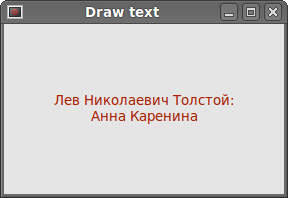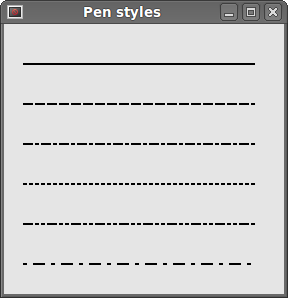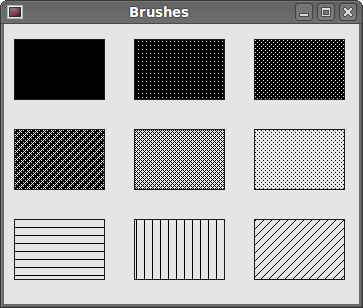Drawing in PyQt4
Drawing is used, when we want to change or enhance an existing widget. Or if we are creating a custom widget from scratch. To do the drawing, we use the drawing API provided by the PyQt4 toolkit.The drawing is done within the
paintEvent() method. The drawing code is placed between the begin() and end() methods of the QtGui.QPainter object. Drawing text
We begin with drawing some Unicode text onto the window client area.#!/usr/bin/pythonIn our example, we draw some text in Azbuka. The text is vertically and horizontally aligned.
# -*- coding: utf-8 -*-
"""
ZetCode PyQt4 tutorial
In this example, we draw text in Russian azbuka.
author: Jan Bodnar
website: zetcode.com
last edited: September 2011
"""
import sys
from PyQt4 import QtGui, QtCore
class Example(QtGui.QWidget):
def __init__(self):
super(Example, self).__init__()
self.initUI()
def initUI(self):
self.text = u'\u041b\u0435\u0432 \u041d\u0438\u043a\u043e\u043b\u0430\
\u0435\u0432\u0438\u0447 \u0422\u043e\u043b\u0441\u0442\u043e\u0439: \n\
\u0410\u043d\u043d\u0430 \u041a\u0430\u0440\u0435\u043d\u0438\u043d\u0430'
self.setGeometry(300, 300, 280, 170)
self.setWindowTitle('Draw text')
self.show()
def paintEvent(self, event):
qp = QtGui.QPainter()
qp.begin(self)
self.drawText(event, qp)
qp.end()
def drawText(self, event, qp):
qp.setPen(QtGui.QColor(168, 34, 3))
qp.setFont(QtGui.QFont('Decorative', 10))
qp.drawText(event.rect(), QtCore.Qt.AlignCenter, self.text)
def main():
app = QtGui.QApplication(sys.argv)
ex = Example()
sys.exit(app.exec_())
if __name__ == '__main__':
main()
def paintEvent(self, event):Drawing is done within a paint event.
qp = QtGui.QPainter()The
qp.begin(self)
self.drawText(event, qp)
qp.end()
QtGui.QPainter class is responsible for all the low-level painting. All the painting methods go between begin()and end() methods. The actual painting is delegated to the drawText() method. qp.setPen(QtGui.QColor(168, 34, 3))Here we define pen and font, which we use to draw the text.
qp.setFont(QtGui.QFont('Decorative', 10))
qp.drawText(event.rect(), QtCore.Qt.AlignCenter, self.text)The
drawText() method draws text on the window. The rect() method of the paint event returns the rectangle that needs to be updated. 
Figure: Drawing text
Drawing points
A point is the most simple graphics object, that can be drawn. It is a small spot on the window.#!/usr/bin/pythonIn our example, we draw randomly 1000 red points on the client area.
# -*- coding: utf-8 -*-
"""
ZetCode PyQt4 tutorial
In the example, we draw randomly 1000 red points
on the window.
author: Jan Bodnar
website: zetcode.com
last edited: September 2011
"""
import sys, random
from PyQt4 import QtGui, QtCore
class Example(QtGui.QWidget):
def __init__(self):
super(Example, self).__init__()
self.initUI()
def initUI(self):
self.setGeometry(300, 300, 280, 170)
self.setWindowTitle('Points')
self.show()
def paintEvent(self, e):
qp = QtGui.QPainter()
qp.begin(self)
self.drawPoints(qp)
qp.end()
def drawPoints(self, qp):
qp.setPen(QtCore.Qt.red)
size = self.size()
for i in range(1000):
x = random.randint(1, size.width()-1)
y = random.randint(1, size.height()-1)
qp.drawPoint(x, y)
def main():
app = QtGui.QApplication(sys.argv)
ex = Example()
sys.exit(app.exec_())
if __name__ == '__main__':
main()
qp.setPen(QtCore.Qt.red)We set the pen to red color. We use a predefined color constant.
size = self.size()Each time we resize the window, a paint event is generated. We get the current size of the window with the
size() method. We use the size of the window to distribute the points all over the client area of the window. qp.drawPoint(x, y)We draw the point with the
drawPoint() method. 
Figure: Points
Colors
A color is an object representing a combination of Red, Green, and Blue (RGB) intensity values. Valid RGB values are in the range 0 to 255. We can define a color in various ways. The most common are RGB decimal values or hexadecimal values. We can also use an RGBA value, which stands for Red, Green, Blue, Alpha. Here we add some extra information, regarding transparency. Alpha value of 255 defines full opacity, 0 is for full transparency, eg the color is invisible.#!/usr/bin/pythonIn our example, we draw 3 colored rectangles.
# -*- coding: utf-8 -*-
"""
ZetCode PyQt4 tutorial
This example draws three rectangles in three
different colors.
author: Jan Bodnar
website: zetcode.com
last edited: September 2011
"""
import sys
from PyQt4 import QtGui, QtCore
class Example(QtGui.QWidget):
def __init__(self):
super(Example, self).__init__()
self.initUI()
def initUI(self):
self.setGeometry(300, 300, 350, 100)
self.setWindowTitle('Colors')
self.show()
def paintEvent(self, e):
qp = QtGui.QPainter()
qp.begin(self)
self.drawRectangles(qp)
qp.end()
def drawRectangles(self, qp):
color = QtGui.QColor(0, 0, 0)
color.setNamedColor('#d4d4d4')
qp.setPen(color)
qp.setBrush(QtGui.QColor(200, 0, 0))
qp.drawRect(10, 15, 90, 60)
qp.setBrush(QtGui.QColor(255, 80, 0, 160))
qp.drawRect(130, 15, 90, 60)
qp.setBrush(QtGui.QColor(25, 0, 90, 200))
qp.drawRect(250, 15, 90, 60)
def main():
app = QtGui.QApplication(sys.argv)
ex = Example()
sys.exit(app.exec_())
if __name__ == '__main__':
main()
color = QtGui.QColor(0, 0, 0)Here we define a color using hexadecimal notation.
color.setNamedColor('#d4d4d4')
qp.setBrush(QtGui.QColor(200, 0, 0))Here we define a brush and draw a rectangle. A brush is an elementary graphics object, which is used to draw the background of a shape. The
qp.drawRect(10, 15, 90, 60)
drawRect() method accepts four parameter. The first two are x, y values on the axis. The third and fourth parameters are width and height of the rectangle. The method draws a rectangle using current pen and current brush. 
Figure: Colors
QtGui.QPen
QtGui.QPen is an elementary graphics object. It is used to draw lines, curves and outlines of rectangles, ellipses, polygons or other shapes. #!/usr/bin/pythonIn our example, we draw six lines. The lines are drawn in six different pen styles. There are five predefined pen styles. We can create also custom pen styles. The last line is drawn using custom pen style.
# -*- coding: utf-8 -*-
"""
ZetCode PyQt4 tutorial
In this example we draw 6 lines using
different pen styles.
author: Jan Bodnar
website: zetcode.com
last edited: September 2011
"""
import sys
from PyQt4 import QtGui, QtCore
class Example(QtGui.QWidget):
def __init__(self):
super(Example, self).__init__()
self.initUI()
def initUI(self):
self.setGeometry(300, 300, 280, 270)
self.setWindowTitle('Pen styles')
self.show()
def paintEvent(self, e):
qp = QtGui.QPainter()
qp.begin(self)
self.drawLines(qp)
qp.end()
def drawLines(self, qp):
pen = QtGui.QPen(QtCore.Qt.black, 2, QtCore.Qt.SolidLine)
qp.setPen(pen)
qp.drawLine(20, 40, 250, 40)
pen.setStyle(QtCore.Qt.DashLine)
qp.setPen(pen)
qp.drawLine(20, 80, 250, 80)
pen.setStyle(QtCore.Qt.DashDotLine)
qp.setPen(pen)
qp.drawLine(20, 120, 250, 120)
pen.setStyle(QtCore.Qt.DotLine)
qp.setPen(pen)
qp.drawLine(20, 160, 250, 160)
pen.setStyle(QtCore.Qt.DashDotDotLine)
qp.setPen(pen)
qp.drawLine(20, 200, 250, 200)
pen.setStyle(QtCore.Qt.CustomDashLine)
pen.setDashPattern([1, 4, 5, 4])
qp.setPen(pen)
qp.drawLine(20, 240, 250, 240)
def main():
app = QtGui.QApplication(sys.argv)
ex = Example()
sys.exit(app.exec_())
if __name__ == '__main__':
main()
pen = QtGui.QPen(QtCore.Qt.black, 2, QtCore.Qt.SolidLine)We create a
QtGui.QPen object. The color is black. The width is set to 2 pixels, so that we can see the differences between the pen styles. The QtCore.Qt.SolidLine is one of the predefined pen styles. pen.setStyle(QtCore.Qt.CustomDashLine)Here we define a custom pen style. We set a
pen.setDashPattern([1, 4, 5, 4])
qp.setPen(pen)
QtCore.Qt.CustomDashLinepen style and call a setDashPattern() method. The list of numbers defines a style. There must be an even number of numbers. Odd numbers define a dash, even numbers space. The greater the number, the greater the space or the dash. Our pattern is 1px dash 4px space 5px dash 4px space etc. 
Figure: Pen Styles
QtGui.QBrush
QtGui.QBrush is an elementary graphics object. It is used to paint the background of graphics shapes, such as rectangles, ellipses or polygons. A brush can be of three different types. A predefined brush a gradient or a texture pattern. #!/usr/bin/pythonIn our example, we draw nine different rectangles.
# -*- coding: utf-8 -*-
"""
ZetCode PyQt4 tutorial
This example draws 9 rectangles in different
brush styles.
author: Jan Bodnar
website: zetcode.com
last edited: September 2011
"""
import sys
from PyQt4 import QtGui, QtCore
class Example(QtGui.QWidget):
def __init__(self):
super(Example, self).__init__()
self.initUI()
def initUI(self):
self.setGeometry(300, 300, 355, 280)
self.setWindowTitle('Brushes')
self.show()
def paintEvent(self, e):
qp = QtGui.QPainter()
qp.begin(self)
self.drawBrushes(qp)
qp.end()
def drawBrushes(self, qp):
brush = QtGui.QBrush(QtCore.Qt.SolidPattern)
qp.setBrush(brush)
qp.drawRect(10, 15, 90, 60)
brush.setStyle(QtCore.Qt.Dense1Pattern)
qp.setBrush(brush)
qp.drawRect(130, 15, 90, 60)
brush.setStyle(QtCore.Qt.Dense2Pattern)
qp.setBrush(brush)
qp.drawRect(250, 15, 90, 60)
brush.setStyle(QtCore.Qt.Dense3Pattern)
qp.setBrush(brush)
qp.drawRect(10, 105, 90, 60)
brush.setStyle(QtCore.Qt.DiagCrossPattern)
qp.setBrush(brush)
qp.drawRect(10, 105, 90, 60)
brush.setStyle(QtCore.Qt.Dense5Pattern)
qp.setBrush(brush)
qp.drawRect(130, 105, 90, 60)
brush.setStyle(QtCore.Qt.Dense6Pattern)
qp.setBrush(brush)
qp.drawRect(250, 105, 90, 60)
brush.setStyle(QtCore.Qt.HorPattern)
qp.setBrush(brush)
qp.drawRect(10, 195, 90, 60)
brush.setStyle(QtCore.Qt.VerPattern)
qp.setBrush(brush)
qp.drawRect(130, 195, 90, 60)
brush.setStyle(QtCore.Qt.BDiagPattern)
qp.setBrush(brush)
qp.drawRect(250, 195, 90, 60)
def main():
app = QtGui.QApplication(sys.argv)
ex = Example()
sys.exit(app.exec_())
if __name__ == '__main__':
main()
brush = QtGui.QBrush(QtCore.Qt.SolidPattern)We define a brush object. Set it to the painter object. And draw the rectangle calling the
qp.setBrush(brush)
qp.drawRect(10, 15, 90, 60)
drawRect() method. 
Figure: Brushes
In this part of the PyQt4 tutorial, we did some basic painting.
Thx !
ReplyDelete